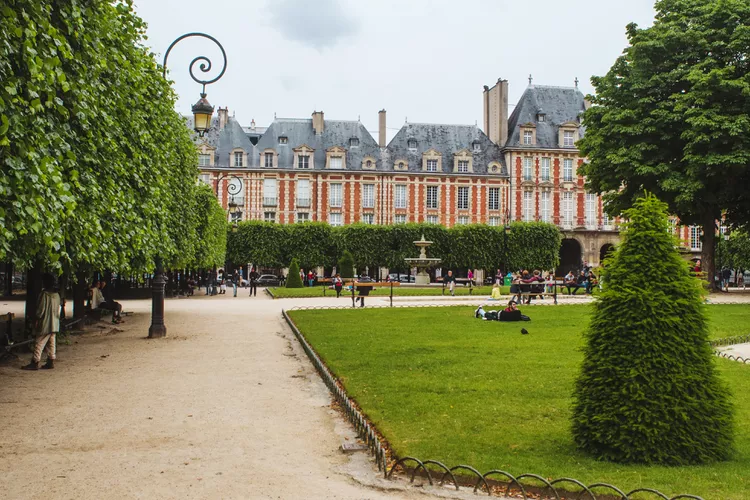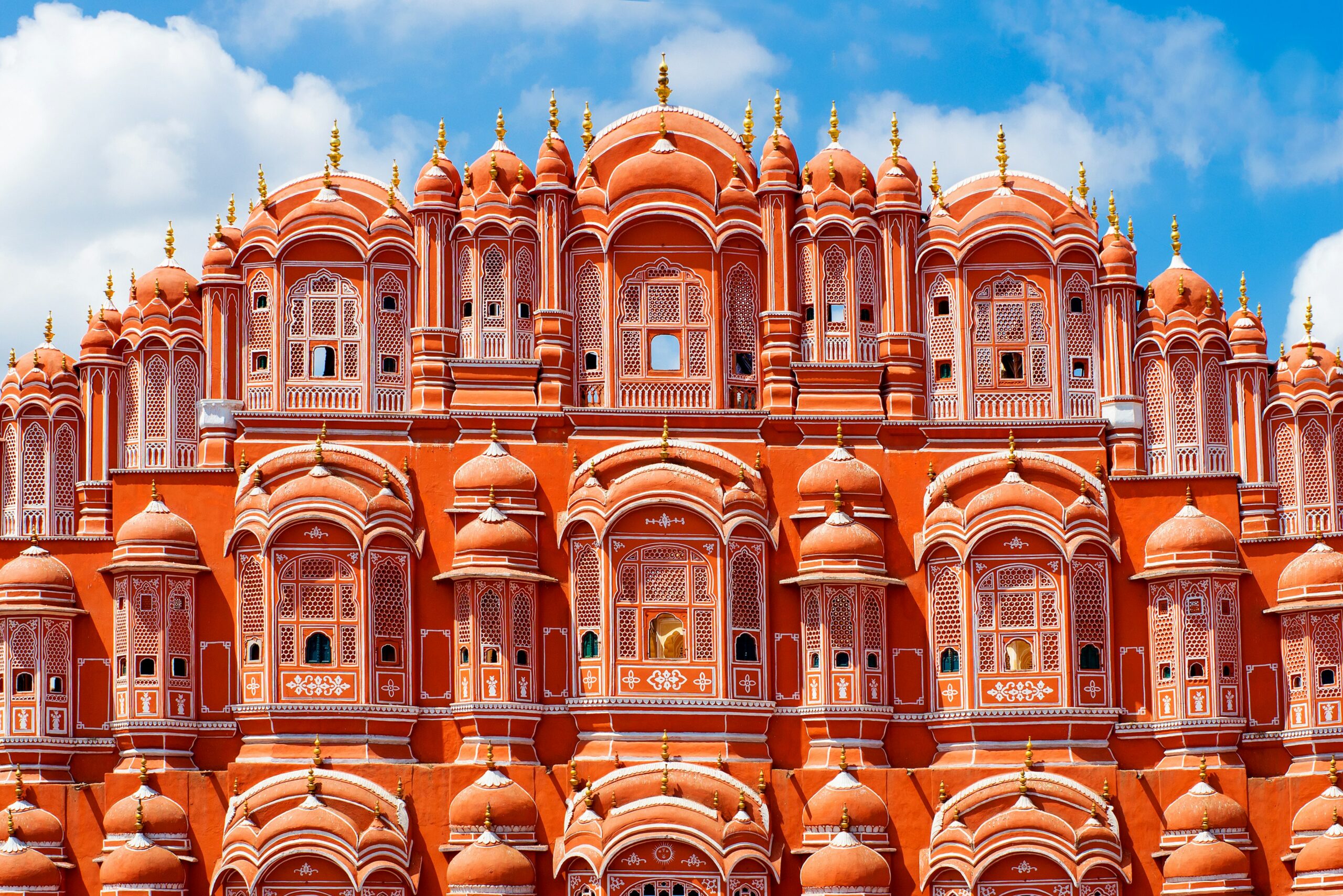One of the loveliest historic squares in Paris, the Place des Vosges is a coveted spot in the French capital for lazy picnics, strolls, window-shopping, and admiring works of art in intimate local galleries. It’s prized for its lush lawns studded with elegant fountains, neatly manicured trees and flowers, and distinctive red-brick mansion houses that border the central green area.
Take a stroll under the high-ceilinged vaulted galleries to window-shop, enjoy a meal out on one of the terraces, or search for the perfect painting to hang in your living room. When it’s warm out, we recommend sprawling out on the grass or a bench to tuck into some scrumptious local street food. Keep reading to learn more about why this former royal square in Paris’ old Marais district is well worth a look on your next trip—and more on how to enjoy it to the fullest.
A Bit of History
The Place des Vosges has a history dating back to the 17th century, and is the city’s first formally-planned public square. The buildings and central gardens visible today were commissioned by King Henri IV and completed around 1612; the square was originally named “Place Royale”.
A symbol of wealth and architectural grandeur, the square embodied the spirit of the Italian and French Renaissance, with its emphasis on geometric harmony, lush green spaces, and lofty but still accessible heights. Its steep slate roofs and easily-recognizable red brick facades make it stand out quite a bit from other buildings in the area, many of which date back to the medieval period.
The central garden in the Vosges, known as the Square Louis XIII, is graced to this day with a statue depicting that particular King mounted on his horse.
Built on the former site of the Place de Tourelles, where King Henri II was fatally wounded in a tournament in the 12th century, the new square would become associated with the French aristocracy of the 17th and 18th centuries. Louis XIII and Anne of Austria celebrated their engagement here, and the Vosges gardens and galleries were favored spots for aristocrats to meet, dine, and gossip.
Famous Denizens and Apartments
Despite its aristocratic ties, few royals have actually lived on the square: Anne of Austria is one of the few to have occupied one of its grand apartments. It has nonetheless housed numerous famous denizens, including Victor Hugo (who resided at #6), Sully, a celebrated minister to Henri IV (#7), the Cardinal Richelieu (#21), and Madame de Sévigné, a countess famed for her wit and prolific literary letters, who was born at #1.
What to See and Do
From picnics and restaurants to museums and art galleries, this grand square packs a remarkable number of worthwhile attractions, whether you’re visiting for the first or third time.
Have a Picnic
Particularly in the spring and summer when the weather allows, this is one of the nicest places for a picnic in Paris. We especially recommend stocking up on delicious local street food and sprawling out on the grass to enjoy it in peace. The Rue des Rosiers, only minutes away, peddles some of the best falafel in Paris (if not the world), and the area is also home to scrumptious gelato, crepes, and French bakery fare.
Window Shop and Browse Art Galleries
The vaulted galleries that gracefully protect the ground floors of the square’s opulent mansions from rain and bad weather are occupied by high-end boutiques and numerous art galleries. The Art Symbol Gallery, specialized in modern and abstract art, is one well-known and respected gallery on the square, located at #21 Place des Vosges. A couple of doors down at #23, the Modus Gallery features the work of contemporary artists from around the globe.
Whether you’re actually in the market for a new piece of jewelry or a fine work of art, or just feel like window-shopping, taking a leisurely stroll around the covered “arcades” is always pleasant, even on chilly, wet days. Many Parisians out on Sunday walks in the Marais head for cover and distraction here until the rain abates.
Visit the Victor Hugo Museum
The author of The Hunchback of Notre-Dame and Les Misérables lived and worked at a corner apartment of the square; the small museum on the same site offers fascinating insight into Hugo’s life and literary efforts. Furniture, letters, manuscripts, and other objects related to one of France’s masters of the human condition are on display in the collection.
Have a Refined Meal on the Terrace, or Inside
The square is also populated by several restaurants offering lunch and dinner. Not all are of excellent quality, but a couple stand out. The Restaurant Anne at the chic Pavillon de la Reine Hotel is a relative newcomer, but is probably the best place on the square for a celebratory dinner. Prices aren’t low here, however, so if you’re on a tight budget and the weather’s nice, stick with picnic fare or choose one of the simpler brasseries nestled within the covered arcades.
Getting There
The Place des Vosges is situated in the 4th arrondissement of Paris, situated near the boundary between the Marais district to the west and the Bastille district to its east.
If you’re coming from the Marais or reserving a few hours to explore the area, the easiest way to reach the square is by getting off at Metro St-Paul (line 4) and walking for approximately seven minutes via Rue Saint-Antoine and Rue de Birague. Rue de Birague eventually turns into the square, which is nearly impossible to miss thanks to its distinctive red-bricked mansions and lush central park area.
You can also get off at Metro Chemin-Vert (line 8), Bastille (line 5 or 8), or Bréguet-Sabin (line 5) to reach the square. This is especially convenient if you plan to venture into the adjoining Bastille neighborhood later in the day.
Things to Do Nearby
There’s a wealth of interesting things to do in the area. Learn more about the neighborhood’s centuries-old history, including its fascinating medieval past and Jewish heritage, on a self-guided walking tour of the Marais.
Head over to the Musée Carnavelet for an in-depth but entertaining history lesson on the city of Paris, or browse the masterpieces of a beloved Spanish painter at the nearby Picasso Museum.
For cutting-edge style, head to the nearby Rue Charlot, where up-and-coming fashion designers have set up their boutiques and design ateliers in stately 18th-century mansions.
Wander down the Rue des Rosiers and the surrounding streets of the Marais to discover delicious Eastern-European and Yiddish bakery goodies, chow down on a hearty falafel sandwich at the famed L’as Du Fallafel, and peruse some of the numerous chic boutiques and gourmet food stores clustered around the area. For tea lovers, afternoon tea and pastries at the Mariage Frères tea house is the perfect follow-up to a whirl through the protected passageways at the Vosges.
Finally, head just a few minutes eastward to the Place de la Bastille, whose imposing Colonne de Juillet looms as a stirring reminder of the Revolution of 1830. This was also where the infamous Bastille prison once stood: a revolt and fire here marked the beginning of France’s first Revolution, in 1789.
On the east end of the square, the ultra-modern Opera Bastille is another easily-recognizable site, with its glass facade and warm glow after dark.




